

Robert Darnton. Site : Essai Maurizio Ferraris - Parcours numériques. Gilbert Simondon - Imagination Et Invention - 1965-1966. Mokafolio - checkmeout.sexy. L'appropriation littéraire des dispositifs del'art contemporain / Marie-Jeanne Zenetti - Université Toulouse-Jean Jaurès (Toulouse II-le Mirail) TLAC programme. 2017-3 : Littératures expérimentales. Écrire, expérimenter, performer au tournant du xxie siècle. Archibald, Samuel, 2009, Le Texte et la Technique : la lecture à l’heure des médias numériques, Montréal, Le Quartanier, coll. « Erres Essais ».
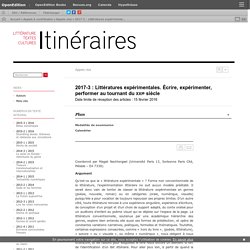
Gérard Genette. "Genette" redirects here.
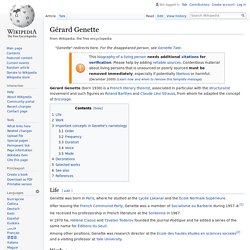
For the disappeared person, see Genette Tate. Gérard Genette (born 1930) is a French literary theorist, associated in particular with the structuralist movement and such figures as Roland Barthes and Claude Lévi-Strauss, from whom he adapted the concept of bricolage. Life[edit] Genette was born in Paris, where he studied at the Lycée Lakanal and the École Normale Supérieure. After leaving the French Communist Party, Genette was a member of Socialisme ou Barbarie during 1957–8.[1] He received his professorship in French literature at the Sorbonne in 1967.
In 1970 he, Hélène Cixous and Tzvetan Todorov founded the journal Poétique and he edited a series of the same name for Éditions du Seuil. Among other positions, Genette was research director at the École des hautes études en sciences sociales[2] and a visiting professor at Yale University. Work[edit] Important concepts in Genette's narratology[edit] Order[edit] Frequency[edit] The Life and Opinions of Tristram Shandy, Gentleman. Novel by Laurence Sterne The Life and Opinions of Tristram Shandy, Gentleman, also known as just Tristram Shandy, is a novel by Laurence Sterne.
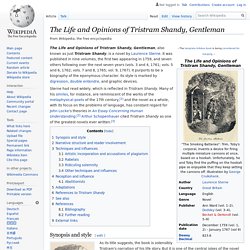
It was published in nine volumes, the first two appearing in 1759, and seven others following over the next seven years (vols. 3 and 4, 1761; vols. 5 and 6, 1762; vols. 7 and 8, 1765; vol. 9, 1767). It purports to be a biography of the eponymous character. Its style is marked by digression, double entendre, and graphic devices. Handmade and Decorative Paper from Paper Mojo. Quand la litta rature fait exposition mzjp 2dvg(1) Revue Littérature 2010/4. Page 14 à 19 Entretien avec Jean-Yves Jouannais Page 20 à 29 Publicisation de la littérature et frontières invisibles du jeu littéraire Page 30 à 36.
La tentation littéraire de l’art contemporain. Derniers usages de la littérature II. Le premier volet de cette série de textes sur l’art et la littérature [1] posait les jalons d’une réflexion sur les liens qu’entretiennent ces deux champs à travers des exemples tirés d’œuvres et d’expositions récentes.
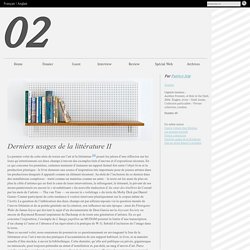
En ce qui concerne les premières, certaines tentaient d’instaurer un rapport formel fort entre l’objet livre et la production plastique : le livre demeure une source d’inspiration très importante pour de jeunes artistes dans les productions desquels il apparaît comme un élément récurrent. Julien Prévieux, Forget the money, 2011. Derniers usages de la littérature. La rencontre entre l’art et la littérature est un serpent de mer qui ne cesse de resurgir avant de replonger dans les replis de l’indifférence jusqu’à ce qu’un écrivain fictionnalise un artiste dans un de ses romans ou qu’un artiste reprenne un bouquin sur une étagère et décide de le réécrire ou de l’incorporer à son travail. Bien sûr, la matière littéraire et l’objet livre ne sont pas tout à fait du même tonneau qu’une planche de contreplaqué ou qu’un morceau de placoplâtre : le livre résiste à l’assimilation, quant au texte, il est volatil.
Si « l’exploitation » de l’objet livre dans des installations ou des oeuvres complexes n’est pas nouvelle, elle s’est vue récemment revisitée par des propositions radicales de jeunes artistes qui s’essaient à prolonger ou à « augmenter » le sens de l’oeuvre, sans pour autant vouloir rouvrir le débat du modernisme et encore moins celui de la transdisciplinarité.
AM70. La lecture sans l'interprétation - F. Jameson. Litt forme ideologique Macherey Balibar. Le champ littéraire - Bourdieu. Revue française d'histoire du livre. Institut d'histoire du livre. Art Monthly : Article : John Douglas Millar on why experimental writing thrives in the art world. John Douglas Millar on why experimental writing thrives in the art world Literature is like phosphorus, it shines with its maximum brilliance at the moment when it attempts to die. – Roland Barthes Writing Degree Zero 1953 ‘It is quite unusual now for a novelist to be very involved in contemporary art, and vice versa,’ the artist and novelist Tom McCarthy said in a 2009 interview with The Believer, ‘but look back to the futurists for example ... what Marinetti did, regenerate writing by hurling it, dragging it through the whirling blades of cinema and mechanical reproduction.’
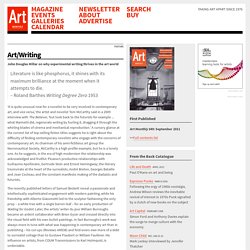
A cursory glance at the current list of top-selling fiction titles suggests he is right about the difficulty of finding contemporary novelists who engage with the concerns of contemporary art. As chairman of his semi-fictitious art group the Necronautical Society, McCarthy is a high profile example, but he is a lonely one. So what are the consequences of this for art? Perhaps this tendency is not yet categorised. Texting: The Artist as Writer as Artist. Reading this, you are probably unfazed.

Likewise you don’t find it strange to see written texts in a bookshop, on a computer screen, or in a journal or newspaper. Yet a shelf of books or even a poem presented as art in a museum seems bizarre. When Seth Price displayed "Essay with Knots," a set of molded plastic panels on which his text "Dispersion" was printed, at the New Museum’s 2010 exhibition "Free," he acknowledged that doing so constituted a "perverse" gesture because "no one will read it! Text doesn’t really work on the wall, not an essay like this. " Perhaps even more perverse was another work in that exhibition, Jill Magid’s "Becoming Tarden," 2009, which consisted of copies of a spy novel she wrote with the same title that was eventually redacted by a real spy agency, the Dutch Secret Service; visitors were invited to pluck one of the volumes from the shelf and read it on the spot, or else buy a copy in the museum store.